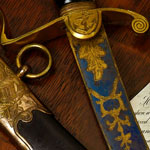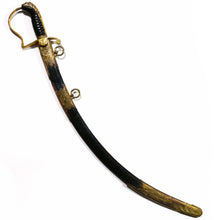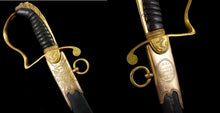Royal Navy - A Georgian Naval Fighting Sword by Salter, Circa 1803
Adding product to your cart
Length overall: 71cm (28in)
Steel, gilt-brass, wood, leather and wire. The curved blade double-edged for the final third of its length, damascened in blue and gold, and engraved with leaves, scrolls and a trophy of arms, to one side. To the other, the stylised ‘GR’ cypher of George III surmounted by the crown. Gilt-brass stirrup guard; the langets engraved with the cable and foul anchor. The ebonised wood handle bound with wire and fitted with a bold lion's head pommel, the mane extending one-third of the length of the gilt back-piece. Complete with black leather scabbard, gilt lockets and chape, all engraved with trophies of arms, the top locket engraved on the reverse side ‘Salter/ Sword Cutler / To H.R.H. the / Duke of Sussex / 35 Strand’.
Read more
Like the 1803 pattern infantry sabre carried by Flank Company officers in the Army, this curved naval sword would have provided its owner with weapon better suited to close quarter fighting than the straight swords commonly used from the mid 1790s. Given a blade length of 60.5cm (23.75in) and no regulation pattern swords until 1805, the present sword was possibly made to the order of a Master, Mate or Midshipman. Captain Bosanquet in his book ‘The Naval Officer’s Sword’ (1955) states that Dress Regulations dictated that a Midshipman might wear a sword similar to the master but ‘of such length as may be convenient’.
The maker of the present sword John Salter (fl. 1802-1827) was sword cutler to Lord Nelson and to Lord Exmouth. In 1802 Nelson left the hat he wore at the Battle of Copenhagen for safekeeping at Salter’s. After Nelson was killed at Trafalgar, his family commissioned Salter to produce the celebrated Nelson mourning rings in gold and enamel to be distributed in his memory to thirty-one relatives and twenty-seven close associates including brother officers, lawyers and prize agents. Salter acquired the patronage of H.R.H. the Duke of Sussex (1773-1843) in 1802.








